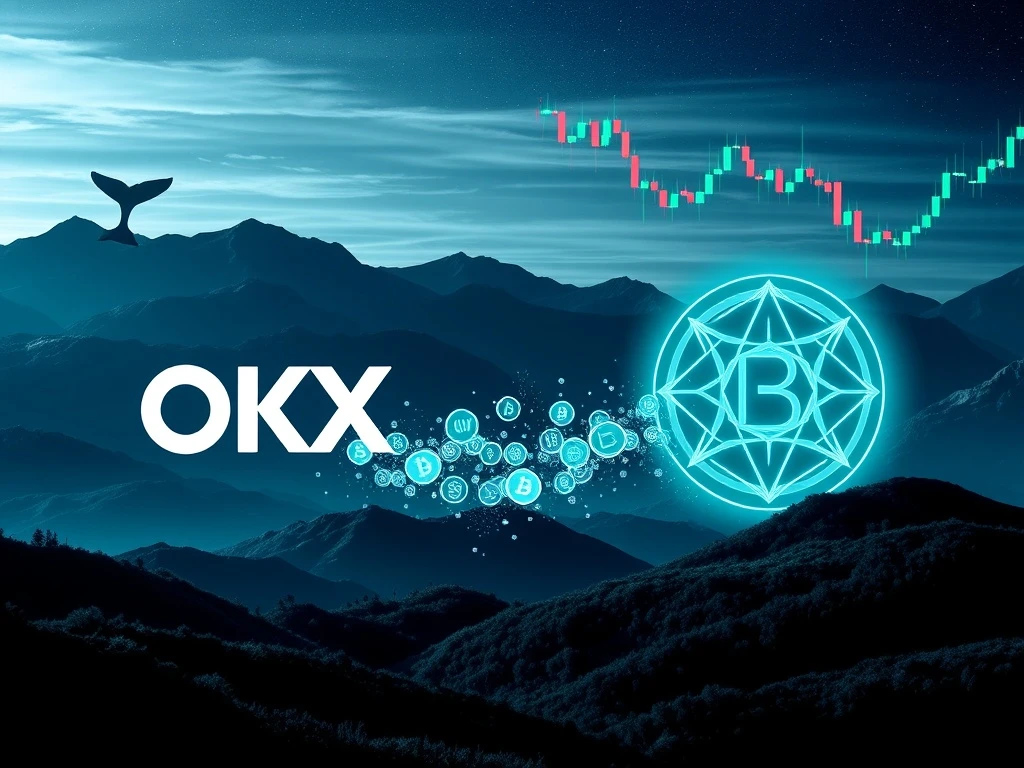Massive USDT Transfer: $501M OKX Whale Move Sparks Intense Crypto Market Speculation

The cryptocurrency world is abuzz following a colossal USDT transfer that sent ripples across the market. A staggering $501 million in USDT, the world’s largest stablecoin, moved from the prominent exchange OKX to an unknown wallet address. This monumental transaction, flagged by the renowned blockchain tracking service Whale Alert, has ignited widespread crypto market speculation regarding its purpose and potential impact.
What Just Happened? The OKX Whale Alert Breakdown
On July 28, 2025, a digital tremor shook the crypto community. A single transaction, amounting to precisely 500,749,291 USDT, was executed from the reserves of OKX, one of the globe’s leading cryptocurrency exchanges. This massive sum landed in a wallet whose owner remains unidentified, triggering immediate alerts from Whale Alert, a service dedicated to tracking large on-chain movements. Such a significant stablecoin movement is rare and typically signals strategic activity by major players, often referred to as ‘whales’ in the crypto space.
While the blockchain’s inherent transparency means every transaction is publicly recorded, the pseudonymous nature of wallet addresses often shrouds the identities of participants in mystery. This duality of public record and private identity is a core characteristic of decentralized finance, yet it leaves much room for interpretation and, inevitably, speculation when such large sums are involved.
Understanding the Significance of a Massive Stablecoin Movement
USDT, or Tether, is designed to maintain a 1:1 peg with the U.S. dollar, making it a cornerstone of the crypto economy. Unlike volatile cryptocurrencies such as Bitcoin or Ethereum, USDT serves as a stable medium for various purposes:
- Capital Transfer: Facilitating quick and cost-effective movement of large sums across exchanges or between entities without converting to fiat.
- Trade Settlement: Used by traders to lock in profits or mitigate losses during periods of high volatility, acting as a temporary safe haven.
- Liquidity Provision: Essential for decentralized finance (DeFi) protocols and centralized exchanges to ensure smooth trading operations.
The sheer volume of this particular USDT transfer underscores its importance. It’s not merely a retail investor moving funds; this scale suggests institutional involvement, high-net-worth individuals, or strategic corporate actions.
Decoding the Mystery: Why Such a Large USDT Transfer from OKX?
The central question on everyone’s mind is: what was the purpose behind this monumental USDT transfer from OKX? Analysts and market observers have put forward several plausible scenarios, each with different implications for the broader market:
-
Cold Storage for Enhanced Security
One of the most common reasons for a large transfer to an unknown wallet is moving funds into cold storage. Cold storage refers to keeping cryptocurrencies offline, making them impervious to online hacking attempts. This is a standard security practice for institutions and high-net-worth individuals holding significant assets. If this is the case, it suggests a long-term holding strategy rather than immediate deployment, signaling confidence in the crypto market’s future.
-
Facilitating an Over-the-Counter (OTC) Trade
For transactions of this magnitude, public exchange order books might not offer sufficient liquidity without causing significant price impact. Over-the-counter (OTC) desks facilitate direct, private trades between two parties, often with the help of an intermediary. This allows large buyers or sellers to execute orders without affecting market prices. The $501 million USDT could be part of an OTC deal, perhaps preparing to acquire a substantial amount of Bitcoin, Ethereum, or other altcoins, or conversely, a large sale of crypto assets for stablecoins.
-
Liquidity Rebalancing Across Platforms
Major market makers, institutional traders, or even the exchange itself might rebalance their liquidity across various platforms or internal wallets. This ensures they have sufficient funds in different locations to meet demand, manage risk, or optimize capital efficiency. A stablecoin movement of this size could be part of a sophisticated liquidity management strategy across global markets or even within different segments of the DeFi ecosystem.
-
Institutional Investment or Treasury Management
As more traditional financial institutions and corporate treasuries venture into crypto, they often consolidate or reallocate their digital assets. This could be a corporate treasury adjusting its crypto holdings, or a large investment fund preparing to deploy capital into new ventures, yield farming protocols, or simply diversifying its portfolio amidst evolving market conditions.
The Role of OKX and Exchange Dynamics
The fact that the transfer originated from OKX, a top-tier global exchange, is noteworthy. Exchanges serve as critical intermediaries for capital flows in the crypto world. While this transaction doesn’t imply any wrongdoing on OKX’s part, it highlights the immense responsibility exchanges bear in managing user funds and facilitating large-scale movements. For exchange users, such events often trigger scrutiny, reinforcing the importance of an exchange’s perceived security, transparency, and robust operational protocols.
The Enigma of the Unknown Wallet: Privacy vs. Transparency
The recipient, an ‘unknown wallet,’ is the core of the mystery. Blockchain analytics tools work tirelessly to trace such addresses, attempting to link them to known entities, exchanges, or behavioral patterns. However, without additional contextual clues, definitive identification remains challenging. This ambiguity perfectly illustrates the fundamental tension within blockchain technology: while every transaction is publicly recorded, privacy is largely preserved for entities that actively seek to obfuscate their identities. This dynamic continues to shape regulatory debates and technological advancements in the crypto space.
Impact on Crypto Market Speculation and Liquidity
While a stablecoin movement itself doesn’t directly drive price volatility in the same way a Bitcoin transfer might, a USDT transfer of this magnitude can significantly influence market sentiment and liquidity. Here’s how:
- Bullish Sentiment: If the funds are poised to be deployed into other crypto assets, it could signal strong buying intent, potentially leading to upward price pressure.
- Risk-Off Behavior: Conversely, if the transfer is a precursor to converting USDT back into fiat currency, it might indicate a move to reduce risk exposure, suggesting a cautious or bearish outlook from the whale.
- Liquidity Shifts: Large movements of stablecoins can affect the liquidity available on different exchanges or within various DeFi protocols, influencing trading efficiency and potential slippage for other market participants.
The ongoing crypto market speculation surrounding this event reflects the market’s sensitivity to large capital flows and the constant search for signals about future price movements.
Actionable Insights for Market Participants: Why Whale Alert Matters
For everyday investors and seasoned traders alike, events like this underscore the critical importance of monitoring on-chain activity. Tools like Whale Alert provide invaluable, real-time insights into large transactions, enabling market participants to:
- Contextualize Movements: Understand the scale and potential implications of major transfers rather than reacting impulsively to news.
- Identify Trends: Spot patterns in large whale movements that might precede significant market shifts.
- Enhance Due Diligence: Gain a deeper understanding of market dynamics beyond just price charts.
This proactive approach allows for more informed decision-making in a rapidly evolving market.
The Maturing Crypto Landscape
The $501 million USDT transfer from OKX serves as a powerful reminder of the maturing infrastructure of cryptocurrency markets. Transactions of this scale now rival those seen in traditional finance, demonstrating the growing institutional adoption and sophistication of digital asset management. As stablecoins like USDT become increasingly central to cross-border settlements, decentralized finance (DeFi) protocols, and global trading strategies, understanding the motivations behind such monumental movements will remain vital for assessing macro trends and navigating the future of finance.
For now, the mystery of the destination wallet persists, a testament to the enigmatic yet data-rich nature of blockchain networks. The crypto community continues to watch, analyze, and speculate, as the digital currents of capital flow onward.
Frequently Asked Questions (FAQs)
1. What is USDT and why is a large USDT transfer significant?
USDT (Tether) is a stablecoin pegged 1:1 to the U.S. dollar, meaning its value is intended to remain stable. A large USDT transfer, like the $501 million from OKX, is significant because stablecoins are primarily used for moving large sums of capital, settling trades, or holding value. Such a large movement often indicates strategic activity by institutional players or high-net-worth individuals, rather than speculative trading, influencing market sentiment and liquidity.
2. What is Whale Alert and how does it relate to this transaction?
Whale Alert is a blockchain tracking service that monitors and reports large cryptocurrency transactions (often referred to as ‘whale’ movements) in real-time. It flagged the $501 million USDT transfer from OKX, bringing it to the attention of the wider crypto community and sparking the current market speculation.
3. What are the common reasons for such a massive stablecoin movement?
Common reasons include moving funds to cold storage for enhanced security, facilitating large over-the-counter (OTC) trades that bypass public exchanges, rebalancing liquidity across different platforms or internal wallets, or strategic asset allocation by institutional investors or corporate treasuries.
4. How does a large USDT transfer impact crypto market speculation?
While USDT itself is stable, a large transfer can fuel crypto market speculation about the whale’s intentions. If the funds are believed to be used for buying other cryptocurrencies, it can signal bullish sentiment. Conversely, if they are suspected to be moving off-exchange for conversion to fiat, it might suggest risk-off behavior. Such movements can also impact liquidity dynamics across exchanges.
5. Why is the destination wallet unknown, despite blockchain transparency?
Blockchain transactions are public, meaning anyone can see the transaction details (amount, sender, receiver addresses). However, wallet addresses are pseudonymous, not directly linked to real-world identities. Unless the wallet is associated with a known entity (like an exchange or a company that publicly discloses its addresses), the owner remains anonymous, preserving privacy despite the transparency of the transaction itself.
6. What is OKX’s role in this transfer?
OKX is a major cryptocurrency exchange from which the $501 million USDT originated. As an intermediary for large capital flows, OKX facilitated the transfer. While the transaction itself doesn’t imply any wrongdoing on OKX’s part, it highlights the exchange’s role in managing significant user funds and its operational capacity for such large-scale movements.









